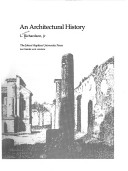Excavations at Popeii have been going on for more than two centuires, since 1748, and discoveries there have regularly produced new and important information about ancient Roman life. The site holds a rich concentration of municipal buildings, houses of every size and condition, villas, and tombs. Now in paperback, the first book of this century written in English devoted to Pompeian architecture and urban development tells the story of the city and its buildings. With text and illustrations, L. Richardson, jr portrays Pompeii in context, as a keystone in the architectural history of antiquity.Pompeii's life was comparatively short. From its meteoric rise as a seaport and shipbuilding center during the First Punic War until its abrupt destruction with the eruption of Vesuvius in A. D. 79, the city passed through four major building periods. After a general introduction to Pompeii's history and geography, the book proceeds through each period, discussing its public buildings, private buildings, and tombs. Each building is described and placed according to its importance in the development of its particular architectural form. Richardson offers new dates and arrives at new conclusions about the development of such important features as the city plan, fortifications, and the atrium/peristyle house. Fifty ground plans and twenty-five photographs illustrate the text.
"There has long been a need for a comprehensive account in English of the architecture and urban development of Pompeii. Richardson's book makes a valiant effort to remedy the deficiency, and will be particularly welcome to all students of Roman architecture"--Classical Review
- ISBN10 080183533X
- ISBN13 9780801835339
- Publish Date 1 May 1988 (first published August 1987)
- Publish Status Out of Stock
- Out of Print 10 September 1998
- Publish Country US
- Imprint Johns Hopkins University Press
- Format Hardcover
- Pages 448
- Language English
